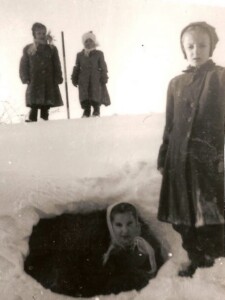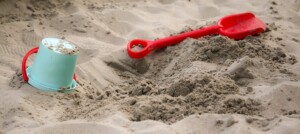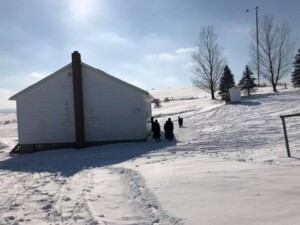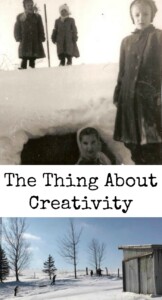The Thing About Creativity in Kids

We are all creative. Some of us seem to be more creative than others. Our creativity is different from one person to another, and there is better or best way to be creative.
It’s not just genetics that gives us creativity. Sometimes it’s our environment, which can also squelch any creativity one might have. There are a lot of people out there who are more creative than I am, that’s for sure.
Yet I can’t tell you how many times my sisters and I were told as young adults, “You girls are so creative!” or how many times I’ve had teachers and friends tell me, “Your kids are so creative!”
I think there’s a reason, and it has more to do with environment than genetics. I haven’t done any studies on this and I’m not a psychologist. But I do know what I’ve experienced and observed, and that counts for something. In fact, it counts for a lot!
No matter the season, my sisters and I found things to do that had nothing to do with extracurricular classes and events. More importantly, we were allowed to play and have fun – and encouraged, at times, to continue our escapades.
Wintertime. Such wonder and excitement when the first snow fell – and then kept falling and falling. By morning, there was plenty of snow to go sledding or build a snowman. In time, the cold on the outside made for excellent building, including creating igloos in the front yard. Inside the igloo, it was actually warm (compared to the wind that was stirring around on the outside).

I wonder how many hours my sisters spent shoveling snow out of the tall bank of snow? They rounded the top of the igloo and made the open space on the inside tall enough for the little sisters to stand upright on the inside. My sisters carved out one long block of snow for a bench or a bed or a shelf. We’d pretend to sleep inside that igloo, curled up in a fetal position, feeling the warmth of the inside creep in onto us.
It didn’t matter that our snow gear (snow pants, jackets, and gloves) were not waterproof and that snow crept down into our boots as we played. We’d come inside dripping wet, snow falling off our clothes in clumps onto the dining room floor. Our older siblings helped us unwrap from the wet and the cold and hung our dripping clothing onto water-filled radiators that bordered the walls of the room. From time to time, we reversed the clothing to the other side to quicken the drying. It didn’t matter that at the end of the day, the snow clothes still had that damp feel and smell that never quite went away. The odor lingered on our hands throughout the day, and the boots never quite dried out as they do now, but it didn’t matter because we had used our minds and our bodies in creating and in having fun!
When my kids were growing up, I’d watch them create and enjoy their creativity. I also realized that much more time was spent creating and planning than the actual playing. They spent an entire day readying a sled track in the woods behind the house. If they hadn’t, there would have been no sledding. I knew that come evening, my floors would be dripping from wet boots and clothing, but it didn’t matter because they were using their brains and their bodies in being healthy and creative.
Summertime.
My kids fleshed out creativity with the houses they built in the woods – sawing off saplings with the claw of a hammer because their father didn’t trust his under eight-year-olds with a saw. They did it when they decided to build a clubhouse in the backyard. Every side and the roof was crooked with light peering through the branches. But they built it fair and square. As they “worked”, muscles were tightened and bones were strengthened; their lungs inhaled fresh outdoor air while they used their brains for something besides screen time.
My sisters and I did it when we created castles in our sandbox – all the way from steps that spired around the outside to the top of the palace – as well as steps on the inside. Or the times we divided up sandlots in that same sandbox and created our own farms and buildings, all made of sand. We used a fork to plow our farm fields in straight rows.

By the time my sisters and I – and years later, my kids – were finished planning and creating, it was usually time to go inside for supper. It didn’t matter. We (and they) had imagined and created for hours at a time, kicking our creativity into such full gear that we were satiated with what we had accomplished.
I remember the days our boys spent in the woods with some cousins, using PVC pipes to channel water from a creek to make a swimming hole. They spent more time building and creating, but they had such fun doing it – not to mention the exercise they got playing and “working” outside for days at a time. Why am I not surprised to see how some of these boys use what they learned way back then in their adult world today?!
Because of what I experienced as a child and because of what I’ve seen in my own kids, I’m a firm believer that play is one of the greatest resources for creativity for a child. One doesn’t need to be a psychologist or therapist to know this. In fact, if we’d spend more time watching kids at play we’d realize how important play is to a child’s development.

A few weeks ago we drove by an Amish school in my home community. It was 9 degrees outside. Do you know what the students were doing during their recess? Playing outside in the cold!
Where I live, parents would be keeping their kids inside for fear of catching a cold in temperatures like that! One group of students commandeered their sleds and saucers down the hill behind the school. The other students took turns lining up to “slide” on the path they had created next to the school. You can be sure that when recess was over, none of those students needed any fidget spinners to calm their nerves.

They’d had all the spinning they needed during their outdoor recess time. We watched them, seeing which one could go the fastest and the farthest down the hill. This is what encouraging creativity in children is about.
I’ll admit that there is some genetics that has been passed on from my ancestors that has helped my kids in the creativity department. Yet I believe that their creativity comes more from being allowed to pretend and play. Everybody has genetics, and what we do with those traits and bents is what determines the outcome of our creativity.
You know what really makes this happen? Adults in the lives of kids who not only allow, but encourage play. Adults who refuse to give in to the popular theory that if somebody else’s kid has a TV in his room and owns a cell phone or an Ipad, then their kid should have one, too.
Forget about the mess and forge a relationship with creativity. To do that, you’ll need some of these items listed below. If many of these are missing from your home, then I would venture to say that your kids have, at times, felt stifled.
- A messy house with tents made of blankets strewn from room to room
- Games and puzzles and lost pieces of both hiding under the sofa
- Play dough or legos or blocks cluttering a floor (from the tower of Babel that crashed)
- Sand (from the sandbox in the yard) sifting off little toes onto a clean kitchen floor
- Little footstools just the right height for a child to reach a kitchen counter, mixer, or cooktop where they can help mix, roll, decorate on their own, and bake
- A trunk of dress-up clothes in easy reach
- Books and tapes with stories (visits to the library if you don’t own a lot of books)
- Storytime – where kids are read to when they’re too young to read
- Crayons for coloring and scribbling in a coloring book
- Good nutrition and naps when kids are young
- Pets to love and play with – or to watch
- Adults in a kid’s life who are willing to do the extra work involved in allowing a child to create
You know what hinders this? (Tell me it ain’t so)
- Fidgit spinners, Ipads, cell phones, and television for hours on end (especially one in a child’s bedroom)
- Gadgets and electronics
- Telling a kid what to play or how to build
- Criticising a child’s creations or scribbled coloring
- Adults who refuse to get down on the floor and play with their kids
- Doing homework or school projects for a child – wherein he is nonverbally told that he can’t do it well enough, thereby stifling his own ideas and opportunity to figure out what he enjoys and what he can do.
The creativity and talent are there inside every kid. As adults, we choose to encourage that creativity or stifle it until there’s no desire left to find his own way in the world. Taking the easiest and fastest road to getting something done is no guarantee that it’s the best way for a child.
[For more ideas about helping your child experience creativity in play, you can click here or here.]
Sit back and encourage your child. You might be surprised at the potential hiding in there, just waiting to be unleashed!
This post contains affiliate links. Your purchase through an affiliate link brings no additional charge to you. I may receive compensation from purchases made through links on My Windowsill. To learn more about affiliate links, you can click here.







